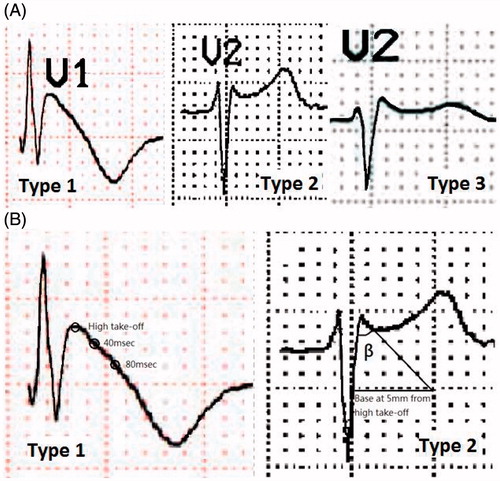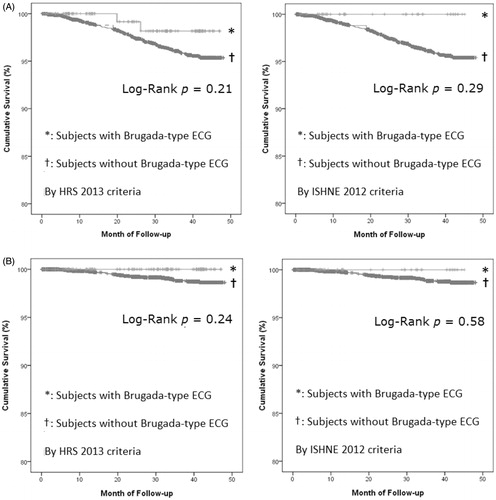Figures & data
Figure 1. Comparisons of the HRS/EHRA/APHRS 2013 and ISHNE 2012 Brugada syndrome ECG criteria. (A). HRS/EHRA/APHRS 2013: Type 1 ECG (coved type); type 2 ECG (saddleback type); type 3 ECG (saddleback with ST-segment elevation <1 mm). (B). ISHNE 2012: Type 1 ECG (coved pattern); type 2 ECG (saddleback pattern) with β angle >58°. ECG = electrocardiographic; HRS/EHRA/APHRS = Heart Rhythm Society/European Heart Rhythm Association/Asia-Pacific Heart Rhythm Society; ISHNE = International Society for Holter and Noninvasive Electrocardiography.

Figure 2. (A). An example of an excluded Brugada-type ECG pattern due to β angle <58° in a 74-year-old woman. (B). An example of an excluded Brugada-type ECG pattern due to J point elevation <0.2 mV in a 66-year-old man. (C). Difference in the numbers of individuals with Brugada-type ECG between 2013 HRS/EHRA/APHRS and 2012 ISHNE criteria. ECG = electrocardiographic; HRS/EHRA/APHRS = Heart Rhythm Society/European Heart Rhythm Association/Asia-Pacific Heart Rhythm Society; ISHNE = International Society for Holter and Noninvasive Electrocardiography.

Table 1. Demographic data and clinical outcomes of the study individuals.
Table 2. Comparisons of electrocardiographic parameters in the individuals with or without Brugada ECG pattern.
Figure 3. Kaplan–Meier survival analysis between individuals with and without Brugada-type ECG patterns according to the criteria proposed by 2013 HRS/EHRA/APHRS and 2012 ISHNE. (A). All-cause mortality. (B). Cardiovascular mortality. ECG = electrocardiogram; HRS/EHRA/APHRS = Heart Rhythm Society/European Heart Rhythm Association/Asia-Pacific Heart Rhythm Society; ISHNE = International Society for Holter and Noninvasive Electrocardiography.


